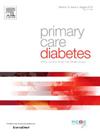结合久坐行为识别2型糖尿病风险:对初级保健的影响。
IF 2.6
4区 医学
Q3 ENDOCRINOLOGY & METABOLISM
引用次数: 0
摘要
2型糖尿病(DM2)是21世纪主要的公共卫生威胁之一。全世界有一半的DM2患者没有被诊断出来。糖尿病的高患病率、诊断不足和并发症突出了确定高危人群的必要性。久坐行为(SB)或久坐是DM2患病率增加的主要易感危险因素。应考虑将SB测量纳入临床实践系统,以识别更可能患有DM2的个体。目的:建立一个数学模型,以临床实践为基础,根据客观数据早期识别办公室员工的DM2风险。方法:采用交叉验证程序进行横断面研究。人体测量变量(性别、年龄和身体质量指数,BMI)、睡眠时间(小时数;通过ActivPAL3M设备测量)和SB模式(久坐休息时间和四种不同长度的久坐时间;通过ActivPAL3M设备测量),比较两组办公室员工(有糖尿病和没有糖尿病的成年人)的健康状况。81名参与者有DM2, 132名有正常的糖代谢(NGM)。使用广义线性模型(GLM),特别是逻辑回归模型对DM2的风险进行建模。结果:数学模型中纳入了与DM2显著相关且无共线性关系的5个非侵入性临床变量:性别、年龄、BMI、睡眠时间(小时)和久坐休息时间。结论:本研究强调了将SB测量纳入初级保健临床实践的重要性。我们的数学模型表明,包括SB可以提高成人DM2风险的早期识别。需要进一步的研究来验证这些发现,并评估数学模型在临床实践中的实际应用。本文章由计算机程序翻译,如有差异,请以英文原文为准。
Incorporating sedentary behaviour for identifying risk of type 2 diabetes: Implications for primary care
Introduction
Type 2 diabetes mellitus (DM2) is one of the main public health threats of the 21st century. Half of the people with DM2 worldwide are not diagnosed. The high prevalence, underdiagnosis and complications of diabetes highlight the need for identifying people at risk. Sedentary behaviour (SB) or prolonged sitting is a major predisposing risk factor for the increasing prevalence of DM2. Incorporating SB measures into clinical practice systems for identifying individuals more likely to have DM2 should be considered.
Objective
To develop a mathematical model for clinical practice that allows early identification of office employees at risk of DM2 based on objective data on SB.
Methods
A cross-sectional study with a cross-validation procedure was conducted. Anthropometric variables (sex, age and body mass index, BMI), sleep time (hours; measured by ActivPAL3M devices), and SB patterns (sedentary breaks and time spent in sedentary bouts of four different lengths; measured by ActivPAL3M devices) of two groups of office employees (adults with and without diabetes) were compared. Eighty-one participants had DM2 and 132 had normal glucose metabolism (NGM). The risk of having DM2 was modelled using generalized linear models (GLM), particularly a logistic regression model.
Results
Five non-invasive clinical variables that were significantly correlated to DM2 with no collinearity were included in the mathematical model: sex, age, BMI, sleep time (hours) and sedentary breaks < 20 minutes (number/day). The validated model correctly classified 94.58 % of the participants with DM2 and 97.99 % of participants with NGM. The sensitivity was 94.58 % and the specificity 97.99 %. Additionally, the model allowed the design of a preventive tool to recommend changes in the SB pattern based on the participant’s anthropometric profile, aiming to reduce the risk of developing DM2 in office employees.
Conclusion
This study highlights the importance of incorporating SB measures in primary care clinical practice. Our mathematical model suggests that including SB could enhance the early identification of adults at risk of DM2. Further research is needed to validate these findings and assess the practical application of the mathematical model in clinical practice.
求助全文
通过发布文献求助,成功后即可免费获取论文全文。
去求助
来源期刊

Primary Care Diabetes
ENDOCRINOLOGY & METABOLISM-PRIMARY HEALTH CARE
CiteScore
5.00
自引率
3.40%
发文量
134
审稿时长
47 days
期刊介绍:
The journal publishes original research articles and high quality reviews in the fields of clinical care, diabetes education, nutrition, health services, psychosocial research and epidemiology and other areas as far as is relevant for diabetology in a primary-care setting. The purpose of the journal is to encourage interdisciplinary research and discussion between all those who are involved in primary diabetes care on an international level. The Journal also publishes news and articles concerning the policies and activities of Primary Care Diabetes Europe and reflects the society''s aim of improving the care for people with diabetes mellitus within the primary-care setting.
 求助内容:
求助内容: 应助结果提醒方式:
应助结果提醒方式:


